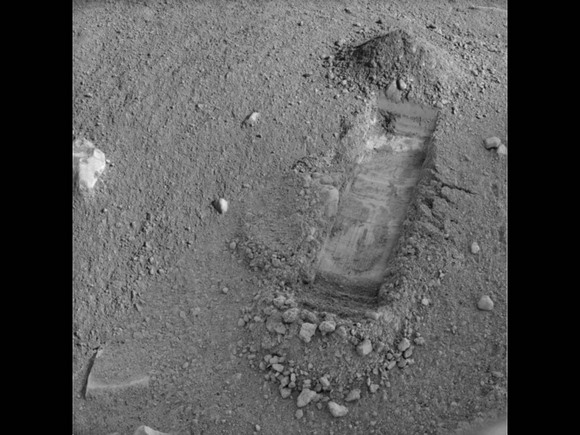The Phoenix lander began digging in an area called “Wonderland” early Tuesday, taking its first scoop of soil from a polygonal surface feature within the “national park” region that mission scientists have been preserving for science. The lander’s Robotic Arm created the new test trench called “Snow White” on June 17, the 22nd Martian day, or sol that Phoenix has been on the Red Planet. However, all of the newly planned science activities will resume no earlier than Sol 24 as engineers look into how the spacecraft is handling larger than expected amounts of data.
During Tuesday’s dig, the arm didn’t reach the hard white material, possibly ice, which Phoenix exposed previously in the first trench it dug into the Martian soil. This trench was only 2 centimeters deep, and the previous trench (the Goldilocks-Dodo Trench) was about 5 cm deep.
So, scientists weren’t surprised at this, and in fact, finding no ice is what they expected and wanted. The Snow White trench is near the center of a relatively flat hummock, or polygon, named “Cheshire Cat,” where scientists predict there will be more soil layers or thicker soil above possible white material.
The Phoenix team plans at least one more day of digging deeper into the Snow White trench. They will study soil structure in the Snow White trench to decide at what depths they will collect samples from a future trench planned for the center of the polygon.
Meanwhile, the Thermal and Evolved-Gas Analyzer (TEGA) instrument continues its ongoing experiment in the first of its eight ovens, and the science team hasn’t yet released any data on the “cooking” at higher temperatures.
TEGA has eight separate tiny ovens to bake and sniff the soil to look for volatile ingredients, such as water. The baking is performed at three different temperature ranges. At the first two temperature ranges, TEGA didn’t detect any water molecules or organics in the soil.
News Source: Phoenix News


Well, where are they? I wish to see more interesting pictures of the surface.
What about the type of reactions Viking was getting?
A 1/3 of the mission is over and they are just dragging their feet. I sure hope they hurry up and get everything done. Never know when something catastrophic may happen.
There are few important questions:
1. The earlier dug trench (Golilocks-Dodo) exposed some clearly visible white material. However TEGA could not find any signs of water in the baked soil sample. It is suspected that it took too long to put the soil sample into TEGA and any water ice could have undergone sublimation. If that be the case, why should we not take fresh picture of Golilocks-Dodo and see if the amount of white material is the same or it has reduced due to sublimation?
2. Why should we start digging another trench before finding out above? We may land up with the same problem in the new ‘Snow White’ trench. The sample picked up could sublimate again and they we would again say the white material has sublimated.
3. The ‘White material’ picked up earlier was very small in quantity in the soil sample and visible only toward one end of the scoop. With the struggle to put the soil into the TEGA oven, it is possible that virtually no ‘white material’ was ever put into the oven. Why should we bake the soil and not the ‘white material’? I believe the scoop should have dug deeper into the Goldilocks-Dodo and picked up the white material and put it into the oven.
4. The White material could be water ice, salt or even dry ice (I do not know why they are not even talking about it inspite of the fact that the whole northern polar cap is white due to predominant dry ice). If they have not found water, have they found NaCl or CO2?
I too suspect “dry ice” (solid CO2). My guess: water will not be found.
I don’t have all the info I need to answer this question for myself, but if water ice would sublimate into the atmosphere on Mars, why haven’t the caps done the same? That is if the caps are indeed water based. Is it more a topic of saturation in the atmosphere or is there something more at work that I don’t understand? Are the caps just too thick to disappear into thin air?
Sorry!
Mars have Watter underground long time ego,
then H2O evaporated in atmosphere, and then tombe on surface in polar regions.
Sincerelly!
I don’t understand that if there is a thick layer of solid ice just inches under this surface, how they expect to get samples of it with a fragile “scoop”, and why they didn’t include a simple core drill? Having said that, I think we should avoid doubting and questioning them too much unti lthey are done. Let’s trust that the designers and operators know best what they are doing. And if they don’t get results, then that will be the lesson for the next design. It is sobering, however, to see how much energy, time and money it takes to do such meagre and risky science. I think we are starting to grasp what a huge hurdle we have to cross to expand into space – serious exploration will take centuries or millenia at this rate.